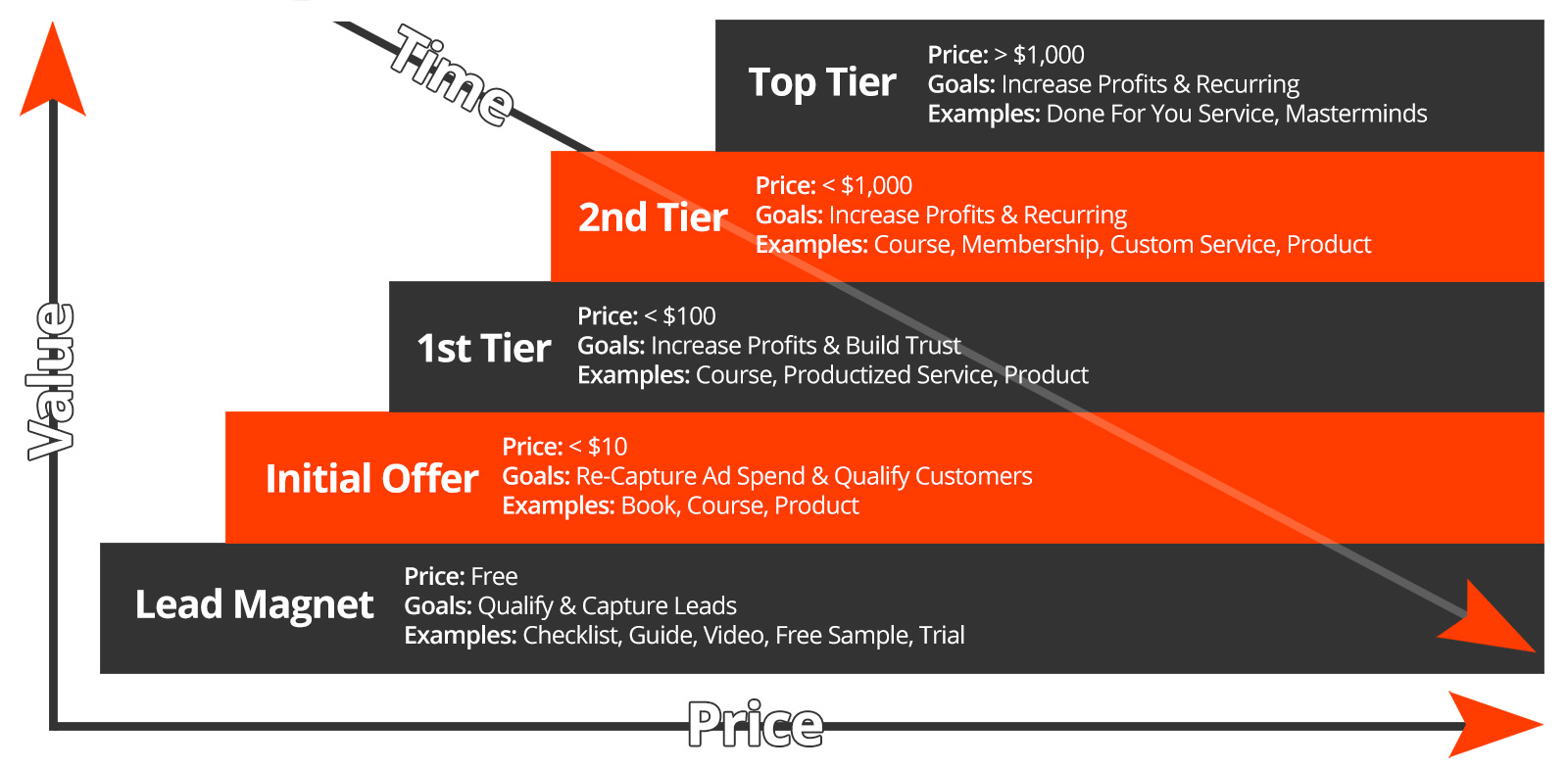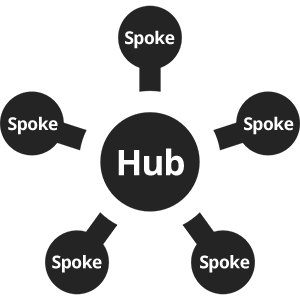This Is Important!
Before charging head first into sales funnel creation, you need to take the time to map out your value ladder – your products and services mapped in ascending order of value and price.
The Value Ladder

General Concept
As people “ascend” your value ladder, they're offered more value; however, this value comes at a price ($).
Note: Value doesn't necessarily mean “more”. You can also provide greater value by saving people time.
Tiers
Your value ladder doesn't necessarily need 5 tiers as the diagram above shows, but offering multiple value tiers at various price points gives you more opportunity to give your customers exactly what they need.
Lead Magnet
The freebies you give away to grow your list and get people in the door.
- Price: Free
- Goals: Qualify & Capture Leads
- Examples: Checklist, Guide, Video, Free Sample, Trial, Coupon
Initial Offer
The low-end products you offer that ideally cover the cost of advertising and “prove” the lead has enough “pain” that they're willing to spend money to resolve it. Many times you'll see “Free plus Shipping” offers.
- Price: < $10
- Goals: Re-Capture Ad Spend & Qualify Customers
- Examples: Book, Course, Product
1st Tier
The low-mid range products and services you offer generate profit while simultaneously building trust with the customer as they receive more value from you and your business.
- Price: < $100
- Goals: Increase Profits & Build Trust
- Examples: Course, Productized Service, Product
2nd Tier
The high-mid range products and services you offer generate profit, ideally recurring revenue, from membership and continuity programs.
- Price: < $1,000
- Goals: Increase Profits & Recurring
- Examples: Course, Membership, Custom Service, Product
Top Tier
The biggest and best product/service you have!
- Price: > $1,000
- Goals: Increase Profits & Recurring
- Examples: Done For You Service, Masterminds
Product Based Businesses
I know what you're thinking, “A value ladder sounds nice, especially for digital and service based businesses, but I sell physical products … and things just aren't “fitting”.”
Don't worry, I've got you covered!

Incorporate The Hub And Spoke Model
The “hub” is the core product and the “spokes” are all the accessories and peripherals that “enhance” the core product.

Many times, businesses that sell physical products can't “ascend” customers the same way as digital and service-based businesses can.
For example, if you sell cars, you can develop and give away a lead magnet and you can likely come up with an initial offer for under $10 (ie. a car buying guide). However, after those first two steps … there's not much … you gotta sell a car!
You're not going to try and sell a motorized bicycle, then a scooter, then a motorcycle, then a car, then a nicer car, then an even nicer car (at least not in one sitting). It simply doesn't work that way; however, after the individual purchases a car they're going to need a lot more stuff – accessories, maintenance, insurance, credit, etc. for years to come.
The car is the “hub” and the additive products/services are the “spokes”.
Eventually, ideally, when the individual is ready for a new car, they'll ascend to the next level, get a new car (hub), and start buying more stuff (spokes).
Another Example (Retail)
A few years ago, when I first came across the value ladder concept, I tried to apply it to an ecommerce business that also had a brick & mortar location. This particular retailer sold women's clothing – dresses, to be exact.
They offered many different types of dresses from seasonal, to work, to formal, to wedding … what “appeared” to be a natural ladder … and it kinda was.
Many times, women would come in for a seasonal dress and leave with two or more dresses – for work and for play. However, there were many occasions where women would only need one type of dress for one specific occasion – ie. a formal occasion.
This was where the hub and spoke model came into play as there are a TON of accessories with formal wear – shoes, bags, jewelry, makeup, etc.
Let's stick with the woman that came in and purchased a formal dress. In this case, a wedding dress, even though it's “technically” the next step in the value ladder, doesn't have to be the next step … especially if she's not engaged and/or doesn't have a boyfriend (or girlfriend, whatever floats your boat – not the point).
The point is, there are likely many seasons and occasions for more dresses (hubs) and accessories (spokes) between now and then that can be capitalized upon, if done correctly.
If it makes sense to ascend people up your ladder, ascend them. If not, be sure to incorporate enough spokes!
Offer Continuity
Often, customers will not ascend your entire value ladder ever, much less in one sitting. For those that do ascend, it can take weeks, months, or even years to ascend to the next level.
This is where offering a continuity program or recurring offer comes into play because it'll help accelerate ascension while increasing capitalization.
For example:
- A car dealership can offer oil changes. Cars need oil changes, making this is a natural offer.
- A dress shop can offer a subscription service where every month or season they send out the appropriate style of sunglasses for maybe $10/mo. Not only will this sell more sunglasses, but it'll serve as a reminder to the customer that they need a new dress for the new season!
- Digital products businesses can offer a community and/or premium support as a recurring offer.
- Dentists offer 6 month check-ups.
Bundles & Down-sells
Bundles and down-sells come in handy, especially if you're stuck or are truly limited in what you have to offer.
Let's say you sell 10 different products, that all cost $30, and don't have any additional accessories, even ones you could offer as an affiliate. (unlikely, but this is a hypothetical!)
Could you create bundles of these products? Maybe a 3 pack, 5 pack, and 10 pack? There's your ladder!
For example:
- This concept can be applied to businesses that only offer one thing, for example, a soft serve ice cream shop. Beyond up-selling more ice cream, they can offer a punch card for $X that grants the holder 5 cups, 10 cups, 20 cups, etc. at various price breaks.
- Barber shops can also take advantage of the bundling concept. While many offer other services like shaves, dyeing, massages, etc., that can bundle into packages, they can also bundle visits onto punch cards in a similar fashion to the ice cream shops.
- Here at Crazy Eye Marketing, we offer courses and resources individually and as a bundle we call The Vault.
Down-Sell Mega Tip!
One of the best ways to help people ascend your value ladder quickly is to reduce the entry price to the next tier.
How?
Payment plans!
Let's say your 1st Tier product costs $97 and your 2nd Tier product costs $247, you can split your 2nd Tier product into 3 easy payments of $93.67!
Doing this makes the 2nd Tier product a no-brainer as it costs less than the 1st Tier product (at least for today – which is what the mind tends to focus on
Reverse The Entire Ladder!
This entire time I've been talking about having customers ascend your value ladder, but what if you reversed it and had them descend?!

You still start with a lead magnet in order to attract and qualify leads, but then you'll go straight into presenting your top tier offer!
If they're not interested, try a “down-sell mega tip” (payment plan). If that doesn't work, move to the 2nd Tier offer. If that doesn't work, try a payment plan. If that doesn't work, move to the 1st Tier offer, and so on.
Who knows, maybe implementing a reversed value ladder will yield greater results … it's certainly worth trying!
Share Yours!
Do you have a value ladder? Are you working on one? Share it below!
More Examples & Support
Do you want more value ladder examples and help brainstorming one for your business? Join The Vault!
